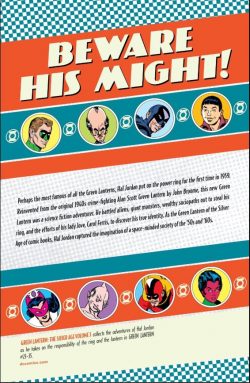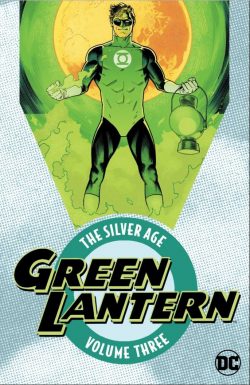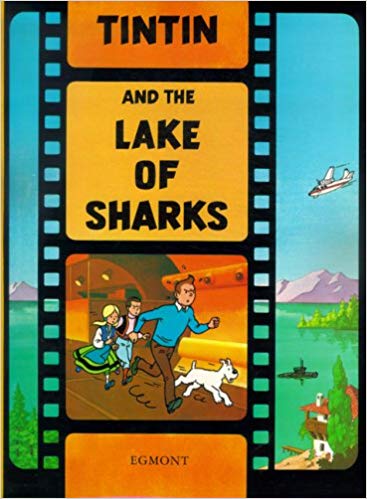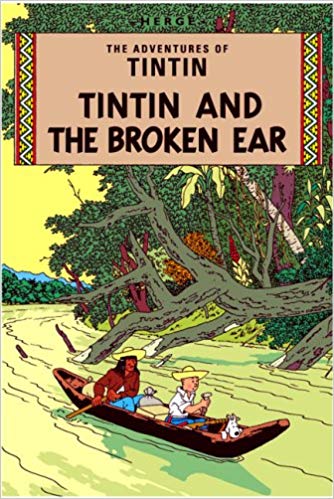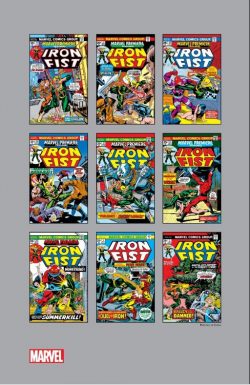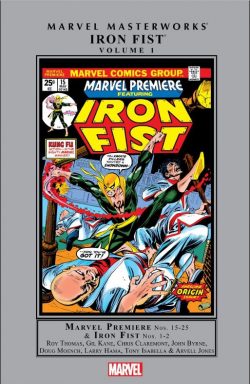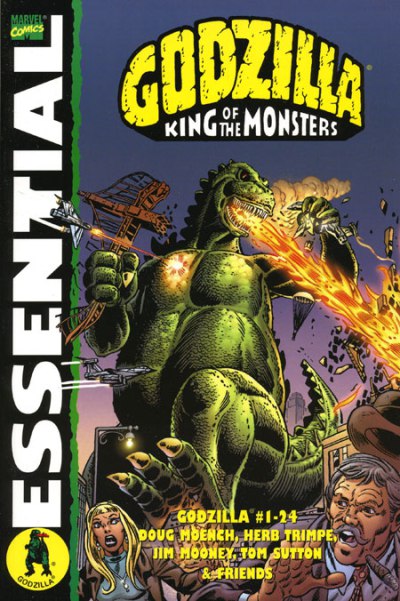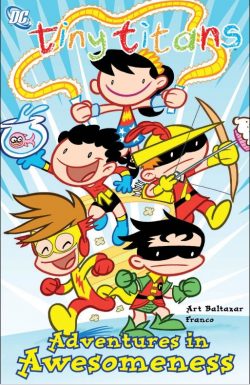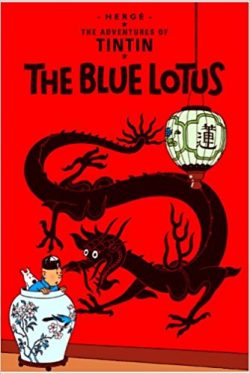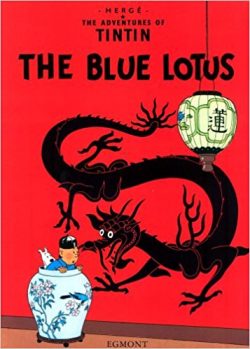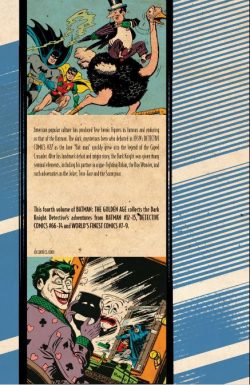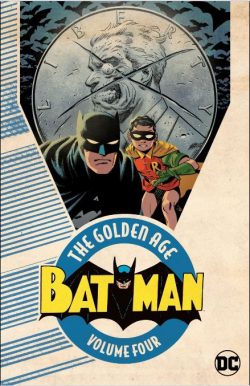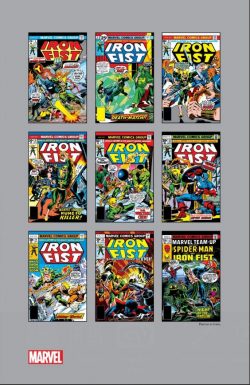
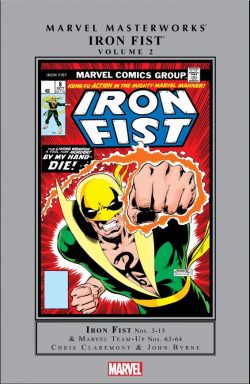
By Chris Claremont, John Byrne & various (Marvel)
ISBN: 978-0-7851-5955-1 (HB)
Comicbooks have always operated within the larger bounds of popular trends and fashions – just look at what got published whenever westerns or science fiction dominated on TV – so when the ancient philosophy and health-&-fitness discipline of Kung Fu made its unstoppable mark on domestic entertainment it wasn’t long before the Chop Sockey kicks and punches found their way onto the four-colour pages of America’s periodicals.
In 1974 Marvel’s second roll of the dice was a blending of Kung Fu tropes and fantasy settings with traditional masked crusader standards. Iron Fist combined Eastern combat philosophy with lost civilisations, magic powers and a proper superhero mask and costume…
The character owed a hefty debt to Bill Everett’s pioneering golden Age super-hero Amazing Man who graced various Centaur Comics publications between 1939 and 1942. The tribute was paid by Roy Thomas & Gil Kane who adopted and translated the fictive John Aman‘s Tibetan origins into something that meshed better with the 1970’s twin zeitgeists of Supernatural Adventure and Martial Arts Mayhem…
This second power-packed collection (available as both sturdy hardback and bantamweight EBook) gathers Iron Fist #3-15 plus a wrap-up tale from Marvel Team-Up ##63-64, collectively ranging from February 1976 to December 1977.
What Has Gone Before: A little more than years previously little Daniel Rand had watched helplessly as his father and mother died at the hands of family friend Harold Meachum whilst the party risked deadly Himalayan snows to find the legendary lost city of K’un Lun.
The boy had travelled with his wealthy parents and their business partner Meachum in search of the fabled city which only appears on Earth for one day every ten years. Wendell Rand had some unsuspected connection to the fabled Shangri La, but was killed before they find it, and Danny’s mother sacrificed herself to save her child from wolves… and their murderous pursuer.
As he wandered alone in the wilderness, the city came to Danny and he spent the next decade training: mastering all forms of martial arts in the militaristic, oriental, feudal paradise. He endured arcane ordeals, living only for the day he could return to Earth and avenge his parents.
After conquering all comers and refusing peace, a home and immortality, Iron Fist touched Earth once more: a Living Weapon able to turn his force of will into a devastating super-punch. As he left K’un Lun, supreme ruler of the city Yü-Ti, the August Personage in Jade, had revealed that murdered Wendell Rand had been his own brother……
After a relentless campaign against Meachum and his heirs, he eventually rejected vengeance but was nevertheless embroiled in cosmic schemes as enemies of city sought him out as a means of accessing the wandering paradise. He had made friends though: adopted by the enigmatic warrior Colleen Wing and her father, an aging professor of Oriental Studies who has fallen foul of a Death Cult. More importantly, he also grew close to her associate Misty Knight: a former cop with a bionic arm.
His greatest nemesis was now sublime wizard Master Khan, who had once attempted to conquer K’un Lun, only to be imprisoned within a crumbling book for his pains, but in the shadows a mysterious stalker dubbed Steel Serpent was getting ever closer to the K’un Lun Kid…
Over the years the prisoner had discovered a temporary escape and subsequently manipulated the Wings and Iron Fist to secure a permanent release and the doom of his jailers.
Another recent cast addition was Princess Azir of Halwan. Master Khan was also apparently intent on killing her and seizing her country…
After Colleen was abducted and her father pushed to the edge of insanity by mind-bending terrorist Angar the Screamer, they were renditioned to Halwan, leaving Danny and Misty to a resolute pursuit…
Following Bruce Canwell’s Introduction on the dream team of Chris Claremont & John Byrne, the action resumes with ‘The City’s Not for Burning!’ (inked by Frank Chiaramonte) with Master Khan attempting to break Colleen in Halwan and the determinedly Danny and Misty frantically giving chase.
They are forced to interrupt their chase with an enforced stopover in England after nuclear-powered maniac The Ravager slaughters innocents and blows up London Heathrow Airport. After defeating Danny on the runway, the monster tops that feat of terrorism by attacking the Post Office Tower (we rebuilt it as the BT Tower, so don’t panic).
With Iron Fist punching way above his weight it inevitably it ends in ‘Holocaust!’ as Ravager is unmasked as old villain Radion the Atomic Man.
He fatally irradiates Danny before the wounded warrior fortuitously discovers the miraculous cleansing and curative power of the Iron Fist and storms to his greatest triumph yet…
With Misty still recuperating in a London hospital, Danny gets involved with a guilt-ridden IRA bomber named Alan Cavenaugh before tackling another of Khan’s assassins in ‘When Slays the Scimitar!’
Danny and Misty finally infiltrate Halwan in #6, courtesy of crusading lawyer Jeryn Hogarth who also promises to secure Danny’s illegally-withheld inheritance and interests from the Rand-Meachum Corporation.
The Pride of K’un Lun doesn’t much care since the successfully brainwashed Colleen has been unleashed by Khan, determined to kill her rescuers in ‘Death Match!’…
None of the earthly participants are aware that, from a hidden dimension, Yü-Ti is observing the proceedings with cold calculation…
By using his mystic Iron Fist to psychically link with Colleen, Danny breaks Khan’s conditioning. Thus, at last, the malignant mage personally enters the fray in #7’s ‘Iron Fist Must Die!’: a blistering battle which breaches the dimensions and exposes the August Personage in Jade’s long-concealed involvement in Wendell Rand’s death.
Given the choice between abandoning his friends on Earth or returning to K’un Lun for answers and justice, the Living Weapon made a true hero’s choice…
A new direction for Iron Fist came with #8 as Danny returns to New York and attempts to pick up the pieces of a life interrupted for more than a decade.
Unaware that Steel Serpent now works for new CEO Joy Meachum, Danny joins the company as an executive, until merciless mob boss Chaka and his Chinatown gangs attack the business ‘Like Tigers in the Night!’ (inked by Dan Adkins). When Iron Fist responds in savage retaliation he is fatally poisoned.
Sportingly offered an antidote if he survives a gauntlet of Chaka’s warriors, Danny triumphs in his own manner when ‘The Dragon Dies at Dawn!’ (Chiaramonte inks). However, when a hidden killer bludgeons Chaka, Danny is once again a fugitive from the cops and dubbed the ‘Kung Fu Killer!’ (Adkins) until he, Colleen and Misty expose the entire plot as a fabrication of the gang lord.
In #11 ‘A Fine Day’s Dawn!’ the Living Weapon squares off against the Asgardian-empowered Wrecking Crew and, with Misty a hostage, is compelled to fight Captain America in #12’s ‘Assault on Avengers’ Mansion!’
Eventually, though, the Pride of K’un Lun and the Sentinel of Liberty unite to turn the tables on the grotesque god-powered gangsters…
In all this intervening time Cavenaugh has arrived in New York, but has not escaped the reach of his former Republican comrades. They hire hitman Boomerang to kill the defector and ‘Target: Iron Fist!’, but with little success, whereas the villain introduced in issue #14 comes a lot closer: even eventually eclipsing Iron Fist in popularity…
‘Snowfire’ – inked by Dan Green – finds Danny and Colleen running for their lives in arctic conditions when a retreat at Hogarth’s palatial Canadian Rockies estate is invaded by deadly mercenary Sabre-tooth. It just wasn’t their week as, only days before, a mystery assailant had ambushed Iron Fist and impossibly drained off a significant portion of the lad’s Shou-Lao fuelled life-force…
Despite being rendered temporarily blind, the K’un Lun Kid ultimately defeats his ferocious foe, but the fiercely feral mutant would return again and again…
With Claremont & Byrne increasingly absorbed by their stellar collaboration on the revived and resurgent adventures of Marvel’s mutant horde, Iron Fist #15 (September 1977) was their last Martial Arts mash-up for a while. The series ended in spectacular fashion as – through a comedy of errors – Danny stumbles into blazing battle against Wolverine, Colossus, Nightcrawler, Banshee, Storm and Phoenix in cataclysmic clash ‘Enter, the X-Men’.
The cancellation was clearly unplanned as two major subplots went unresolved: Misty had disappeared on an undercover assignment to investigate enigmatic European gang-boss John Bushmaster and Danny again had his chi siphoned off by Steel Serpent…
Fans didn’t have to wait long: Claremont & Byrne had already begun their magical stint on Marvel Team-Up: turning the Spider-Man vehicle into their own personal clearing house for unresolved plot-lines.
MTU #63-64 (November & December 1977 and inked by Dave Hunt) at last revealed the secret of K’un Lun exile Davos in ‘Night of the Dragon’ as Steel Serpent sucked the power of the Iron Fist from Danny, leaving him near death. Risking all she had gained, Misty broke cover and rushed to his aid…
With the wallcrawler and Colleen (the warrior women using the team name “Daughters of the Dragonâ€) to bolster him, Iron Fist defeats Davos and reclaims his heritage in ‘If Death be my Destiny…’ before shuffling off into a quiet retirement and anonymity.
…But not for long – and certainly the subject of further mammoth full-colour collections to come…
The Iron Fist saga ranks amongst the most exciting and enjoyable Costumed Dramas of Marvel’s second generation. If you want a good, clean fight comic this is probably one of your better bets, especially if you’re a fan of original artwork as this titanic tome closes with a fabulous selection, shot from Byrne’s pages and inked by Adkins, Green and Hunt…
© 1976, 1977, 2017 Marvel Characters, Inc. All rights reserved.

